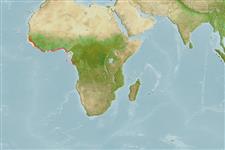Elasmobranchii (Haie und Rochen) (sharks and rays) >
Carcharhiniformes (Ground sharks) >
Sphyrnidae (Hammerhead, bonnethead, or scoophead sharks)
Etymology: Sphyrna: Probable misspelling of sphyra (Gr.), hammer, referring to their hammer-shaped heads (See ETYFish).
Eponymy: Monsieur Couard was Director of shark fisheries off the coast of Senegal, the type locality. Unfortunately we can find nothing more about him. (Ref. 128868), visit book page.
Issue
Junior synonym of Sphyrna lewini (Griffith & Smith 1834) in Ref. 94083,106604. This page will be deleted.
Environment: milieu / climate zone / Tiefenbereich / distribution range
Ökologie
seewasser benthopelagisch. Tropical; 17°N - 5°S, 19°W - 13°E
Eastern Atlantic: Senegal to Congo. Not in Compagno's 1999 checklist (Ref. 35766).
Size / Gewicht / Alter
Geschlechtsreife: Lm ? range ? - ? cm
Max length : 300 cm TL Männchen/unbestimmt; (Ref. 244)
A coastal-pelagic shark. Feeds on fishes, especially bony fishes, and also benthic and epibenthic cephalopods. Viviparous, with 24 to 28 young in a litter. Size at birth about 30 to 32 cm.
Life cycle and mating behavior
Geschlechtsreife | Fortpflanzung | Ablaichen | Eier | Fecundity | Larven
Viviparous, placental (Ref. 50449).
Compagno, L.J.V., 1984. FAO Species Catalogue. Vol. 4. Sharks of the world. An annotated and illustrated catalogue of shark species known to date. Part 2 - Carcharhiniformes. FAO Fish. Synop. 125(4/2):251-655. Rome: FAO. (Ref. 244)
IUCN Rote Liste Status (Ref. 130435: Version 2025-1)
Bedrohung für Menschen
Traumatogenic
Nutzung durch Menschen
Fischereien: kleinfischerei
Tools
Zusatzinformationen
Download XML
Internet Quellen
Estimates based on models
Preferred temperature (Ref.
123201): 24.4 - 28, mean 26.7 °C (based on 64 cells).
Phylogenetic diversity index (Ref.
82804): PD
50 = 0.5006 [Uniqueness, from 0.5 = low to 2.0 = high].
Bayesian length-weight: a=0.00347 (0.00153 - 0.00788), b=3.12 (2.93 - 3.31), in cm total length, based on LWR estimates for this (Sub)family-body shape (Ref.
93245).
Trophic level (Ref.
69278): 4.5 ±0.54 se; based on food items.
Widerstandsfähigkeit (Ref.
120179): niedrig, Verdopplung der Population dauert 4,5 - 14 Jahre. (Fec=24).
Fishing Vulnerability (Ref.
59153): Very high vulnerability (90 of 100).
🛈
